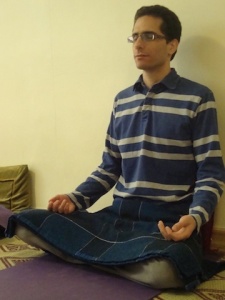Story by Kimberly Russell // Photos by Kimberly Russell and Emily Rudisill
AMMAN, Jordan – Look at her resume and Dina Khairy has all the makings of a successful yoga instructor. She studied under a master – Samira Dajani, one of the first in Jordan to teach the discipline – and spent time training in New York City before returning to the Middle East to teach her own classes.
But it’s been slow going in Amman, where she’s trying to work in a culture that Khairy believes is resistant to yoga because of religious concerns and the simple fact that it’s not part of regular society. Many people, she thinks, also view it as a luxury they can’t afford.

Yoga is not new to Amman, but it took a long time to catch on. Slowly, that's changing. (Photo by Kimberly Russell)
“People here have a hard time spending money on something like yoga or a gym,” said Khairy, who teaches out of her studio apartment in Amman. “It’s not a health or exercise culture.”
Yoga is not new in Amman. In fact, Dajani has taught the principles of yoga to interested Jordanians for more than 30 years. However, it wasn’t until the past decade that Jordanians showed interest in learning the art of yoga, and even now it remains a relatively unknown practice to locals.
Dajani, who reportedly became the first person to teach a yoga class in Jordan in 1972, helped to expand the practice in what was once viewed as an unlikely venue. Since taking her class, many students say they have pursued yoga on a deeper level, often traveling to other countries to learn more about it and ultimately become teachers themselves.
Ghada Muasher, another of Dajani’s students, has also gone on to open a studio of her own on Dimashq Street in Amman. Although she is not a teacher, she hand picks only the finest yoga instructors in the area, and attends many of her home studio classes.
While on vacation with her husband, she found herself incorporating the moves she learned while snorkeling, and built from that a yoga-based fitness regimen called One With Nature that that garnered a large following across the Middle East. She also created a regimen for children called “I Can.” Her success has also led her to create clothing lines, a children’s book and in-flight movie shorts for stretching on a plane
“It all made sense. I looked at the sea animals and their movement, and it clicked with me, the way the animals moved,” said Muasher. “Yoga is about being one with nature, and learning from their movements helped me to understand why yoga made me feel so good.
Though it is hard to find women to fill yoga classes in Amman, there are locals like Manal Sehalimit, a newcomer who started practicing at a local gym.
She, like the others, hopes that more people will try yoga, but fears that the religion-driven culture keeps people from pursuing it.
“It’s hard for people to accept yoga because they are afraid it will conflict with their religion,” Sehalimit said. “At least for a lot of people I know, they’re worried about it because it’s associated with Buddhism and Hinduism.”
Still, there are moments, she says, when she’s pleasantly surprised to find yoga making cultural inroads in mainstream society. Sehalimit remembers turning on the television during Ramadan and seeing a Muslim-run station featuring a yoga guru.
“There was one Lebanese woman who was always on the TV and radio, and I think it showed people that it was OK to practice yoga without being afraid they weren’t being true to their religion,” she said.
Many instructors report that they have to emphasize that constantly.
“Yoga means ‘to join together’ or ‘connect,’ and people think [because of this] that it is a religion, but it has nothing to do with religion,” said Dajani. “It’s a philosophy, a way of life. We want to help people have a healthier body and mind, but we don’t want to affect their beliefs. We accept people of all religions.”
The very idea that yoga is connected to a religion frustrates Christian Matta, yoga instructor at Art of Living of Jordan on May Ziadeh Street in Amman.
“Yoga is all about making people happy, and people making other people happy. We focus mainly on breathing techniques. Breathing has no religion,” Matta said. “There should be no conflict. It’s scientific, yoga heals.”
When Art of Living is doing well financially, instructors there will host community yoga classes for the less fortunate of the area who can’t afford it otherwise. However, this is not always the case, and Matta hopes the business will generate enough profit to allow for more of these programs.
Khairy finds the same struggles, but prepared for this before she opened her studio. “I knew I wouldn’t be as successful as I could be in other jobs, but that was something I gave up to do this. I don’t regret it, I love my job,” she said, “but I think I had hoped it would take off more than it has.”


